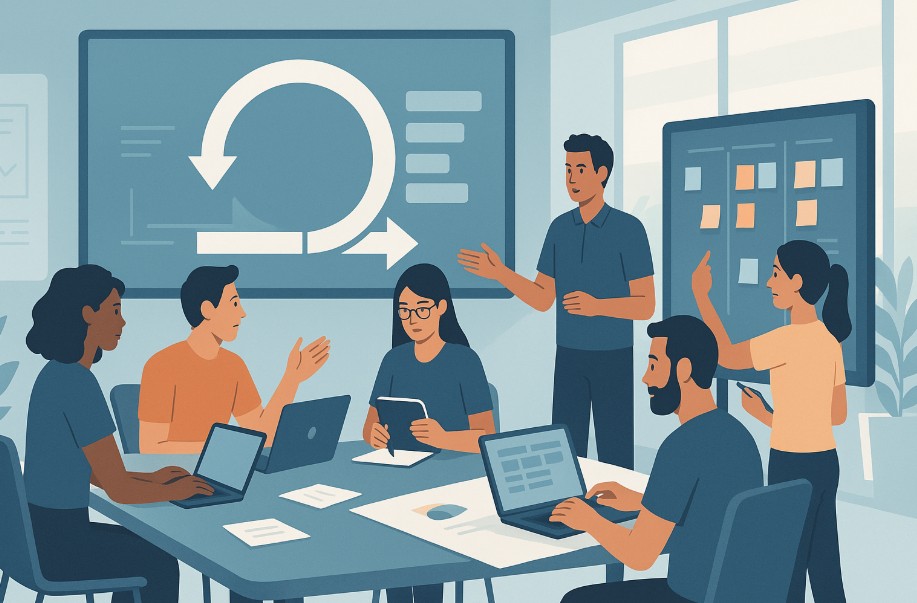
How can software teams keep up with rapid technological changes, unpredictable client demands, and an ever-evolving competitive landscape? What development process allows room for flexibility, fosters collaboration, and ensures a constant delivery of value? The answer lies in the agile model in software engineering.
Unlike traditional linear development models that require complete requirement definitions at the beginning, Agile embraces change. It empowers teams to build software incrementally through iterative cycles, delivering functioning software early and frequently.
As digital transformation accelerates, Agile has become the preferred methodology across the globe, not only for software companies but also for organisations in healthcare, finance, education, and government.
This blog will explore in-depth what the Agile model is, how it works, the principles that guide it, and why it has become the cornerstone of modern software engineering.
What is the Agile Model in Software Engineering?

The Agile model in software engineering is a collection of development methodologies based on iterative development. In Agile, requirements and solutions evolve through collaboration between self-organising, cross-functional teams.
It was designed primarily to address the limitations of rigid models like the Waterfall methodology by providing a more adaptive and responsive structure.
One of the core objectives of the Agile model is to complete projects faster by reducing or eliminating steps that don’t add value. Agile development doesn’t follow a fixed sequence. Instead, it follows a flexible approach that allows changes even late in the development process without derailing the entire project.
Each cycle in Agile is called an iteration or sprint, typically spanning between 1 to 4 weeks. At the end of each sprint, the team releases a working product or feature, collects feedback from stakeholders, and uses this input to shape the next sprint. This feedback-driven model ensures that the final product closely aligns with user expectations.
Agile is not a single process but a family of methodologies including Scrum, Kanban, Lean, and Extreme Programming (XP), among others. Each framework shares core Agile values and principles but applies them differently depending on the nature of the team and project.
How Does the Agile Software Development Life Cycle Work?
The Agile Software Development Life Cycle (SDLC) is a set of stages that guide a project from initiation to retirement. Each stage is designed to support flexibility, adaptability, and continuous improvement.
1. Requirement Gathering
This phase involves close interaction between the development team and the client or stakeholders. The goal is to understand the client’s needs, identify essential features, and evaluate whether the project is technically and economically viable. Unlike traditional models, Agile doesn’t require all requirements to be documented upfront; instead, they evolve over time based on continuous discussions and discoveries.
2. Designing Requirements
Once the initial requirements are gathered, system architecture and high-level designs are prepared. Teams may use user flow diagrams, wireframes, and Unified Modeling Language (UML) diagrams to visualise the design. Prototyping is often used at this stage to give stakeholders a tangible preview of the application’s structure and functionality.
3. Iteration and Construction
The core of Agile lies in iterative development. The team develops software features in small batches. Each sprint focuses on building a part of the overall system. Coding, implementation, integration, and internal reviews all happen within the same iteration. By the end of a sprint, a potentially shippable product increment is available.
4. Testing and Quality Assurance
Testing is not an afterthought in Agile; it is continuous and integrated. Agile promotes Test-Driven Development (TDD) and Behaviour Driven Development (BDD) to ensure that code meets the functional requirements from the start.
Types of testing include:
- Unit testing (testing individual code units)
- Integration testing (ensuring modules work together)
- System testing (validating the application against user requirements)
5. Deployment
After testing, the product increment is deployed to a staging or production environment. Agile promotes continuous delivery, meaning each release is functional and potentially usable by the customer. Deployment isn’t a one-time event; it happens after every sprint.
6. Feedback and Review
Feedback is gathered from stakeholders, users, and testers. This feedback loop is crucial for refining the product and influencing the next cycle of development. Based on user input, the team may change existing features, add new ones, or even re-prioritise the product backlog.
What Are the Key Principles and Values of Agile?

The Agile model is guided by the Agile Manifesto, which was established in 2001 by 17 software development practitioners. The manifesto outlines four values and twelve principles that serve as the foundation for all Agile practices.
The Four Core Values of Agile:
- Individuals and interactions over processes and tools: People are the driving force behind software development.
- Working software over comprehensive documentation: Delivering value is more important than producing excessive paperwork.
- Customer collaboration over contract negotiation: Customers should be engaged throughout the process.
- Responding to change over following a plan: Flexibility is preferred over rigid planning.
The 12 Principles of Agile:
- Deliver working software frequently
- Welcome to changing requirements
- Collaborate with stakeholders daily
- Build projects around motivated individuals
- Maintain a sustainable pace
- Prioritise face-to-face communication
- Use working software as the measure of progress
- Encourage technical excellence
- Promote simplicity
- Let self-organising teams flourish
- Reflect regularly to improve
These principles enable Agile teams to remain flexible, proactive, and aligned with business goals throughout the software development lifecycle.
What Are the Most Popular Agile Methodologies?
Agile methodologies vary in practice but adhere to the same core values.
The most widely adopted methods include:
| Methodology | Key Features |
| Scrum | Time-boxed sprints, product backlog, sprint planning, daily stand-ups |
| Kanban | Visual workflow board, continuous delivery, WIP limits |
| Lean | Eliminates waste, improves flow, and empowers decision-making |
| XP (Extreme Programming) | Emphasises code quality, TDD, pair programming |
| Crystal | Lightweight and adaptable, focuses on team size and criticality |
| DSDM | Strict project governance, prioritised requirements, timeboxing |
| FDD (Feature-Driven Development) | Develops by features, suited for large teams and scalable projects |
Each methodology can be tailored to fit specific organisational needs and project sizes.
When Should the Agile Model Be Used?
The Agile model is most effective in environments where requirements are likely to change and fast delivery is essential.
It is especially beneficial when:
- The client or market requires regular updates and feedback
- Project scope and goals are likely to evolve
- Teams are cross-functional and collaborative
- Rapid prototyping is needed
- Time-to-market is a competitive advantage
Agile thrives in dynamic environments where adaptability and speed outweigh rigid planning.
What Are the Advantages of the Agile Model?
Agile has gained widespread adoption because it offers several significant advantages over traditional development models.
- Faster Releases: Agile’s iterative process enables early and frequent delivery of working software.
- Customer Satisfaction: Regular stakeholder engagement ensures that the final product matches expectations.
- Improved Team Collaboration: Daily stand-ups and retrospectives keep teams aligned.
- Flexibility: New requirements can be incorporated at any stage.
- Better Risk Management: Issues are identified early, reducing the chances of project failure.
These benefits contribute to higher quality products and more satisfied users.
What Are the Disadvantages or Challenges of Agile?

Despite its strengths, Agile is not without limitations:
- Lack of Documentation: Agile often minimises documentation, which may create challenges during maintenance.
- Dependency on Team Expertise: Agile requires skilled developers capable of self-organising.
- Unclear Forecasting: Sprints make long-term planning more complex.
- High Customer Involvement: Some clients may not have time for frequent interactions.
- Over-Customisation: Some teams create hybrid models that dilute Agile’s benefits.
These challenges can be mitigated through training, strong leadership, and experience with Agile frameworks.
How Does Agile Compare to the Waterfall Model?
Agile and Waterfall represent two contrasting approaches to software development.
Below is a comparative overview:
| Factor | Agile Model | Waterfall Model |
| Approach | Iterative and incremental | Sequential and linear |
| Flexibility | High | Low |
| Planning | Adaptive | Rigid |
| Customer Feedback | Continuous | Only at start and end |
| Testing | Ongoing | After development |
| Delivery | Frequent releases | One final release |
Agile is best suited for dynamic projects with evolving needs, while Waterfall works for projects with fixed scope and clear requirements from the start.
Conclusion
The agile model in software engineering has transformed the way software is developed, tested, and delivered. By shifting the focus from rigid planning to adaptive execution, Agile fosters a culture of collaboration, transparency, and continuous improvement. Teams are empowered to release better software, faster, and more efficiently.
In a world where customer needs evolve rapidly and competition is fierce, Agile offers a proven strategy for delivering business value early and often. It’s not just a methodology, it’s a mindset that has shaped the future of software engineering.
FAQs
How is Agile different from Waterfall?
Agile is iterative and allows ongoing feedback and changes, while Waterfall is linear and requires full planning before development begins.
What are common Agile methodologies?
Popular Agile methods include Scrum, Kanban, Lean, Extreme Programming (XP), and Feature-Driven Development (FDD).
When should Agile be used?
Agile works best for projects with evolving requirements, active user involvement, and a need for rapid, incremental delivery.
Is Agile suitable for large teams?
Yes, Agile can scale using frameworks like SAFe (Scaled Agile Framework) or LeSS (Large-Scale Scrum).
Does Agile require documentation?
Agile minimises documentation but doesn’t eliminate it. It focuses on useful, just-in-time documentation that supports development.
What are the main benefits of Agile?
Agile improves product quality, speeds up delivery, enhances collaboration, and ensures software meets user expectations.